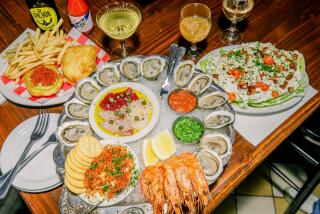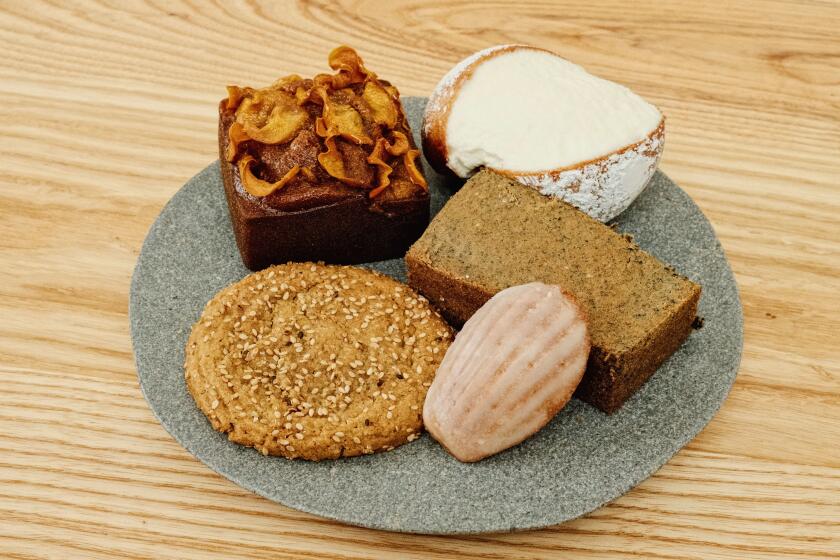Good Looking It’s Not, but Shellfish Is a Lovely Source of Nutrition
There is probably no stranger or more prehistoric-looking group of creatures than that which lives beneath the sea. The fact that most of these animals are edible is of little consequence to people who don’t know what to do with them.
For many, shellfish begins, and ends, with shrimp and lobster, which are often thought of as dietary (and economic) indulgences. But a healthful diet has plenty of room for shellfish because it is generally low in calories and saturated fat, and, like regular fish, contains the beneficial omega-3 fatty acids. Shellfish is also an excellent source of protein, iron and some trace minerals like copper and zinc.
Shellfish should never be eaten raw. Fortunately, it lends itself to many cooking and serving methods. Here’s a sample:
Clams: These bivalves are, for the most part, caught in local waters. They are available year-round and may be soft- or hard-shelled. Clams are generally sweet and a little chewy, depending on size and species. They are sold fresh, in the shell or shucked and packed in their own juices. You can also buy them frozen and canned. (If they are in the shell, they must be kept alive until cooking because they begin to decompose quickly.)
A 3 1/2-ounce serving has 148 calories, 2 grams of fat, less than 1 gram of saturated fat and 67 milligrams of cholesterol.
Crabs: Found in both the Atlantic and Pacific oceans, crabs are sold alive. Their meat is delicately sweet, firm yet flaky, and is available fresh cooked, frozen and canned.
Like clams, they can be hard-shelled or soft-shelled. Hard-shelled crabs are best boiled and steamed, while soft-shelled varieties are usually sauteed or broiled.
Depending on the type of crab, a 3 1/2-ounce portion has 90 to 100 calories, 2 grams of fat, less than 1 gram of saturated fat and 50 to 100 milligrams of cholesterol.
Crayfish: The mainstay of Louisiana Cajun cuisine, crayfish look like little lobsters, and are found in freshwater lakes, streams and rivers. They are most commonly served whole and eaten like lobsters or crabs.
Unfortunately, they are high in cholesterol, but a 3 1/2-ounce portion has only 114 calories, 1 gram of fat and less than 1 gram of saturated fat.
Lobsters: The best specimens in the United States come from Maine and are sweet, firm and succulent. Available year-round, the bulk of the catch is harvested in the summer and fall. Lobsters should be cooked alive or when just freshly killed. They are sold frozen as well.
A 3 1/2-ounce portion of lobster on its own contains only 98 calories, 1 gram of fat, less than 1 gram of saturated fat and 72 milligrams of cholesterol. But if you add drawn butter or creamy sauces, you can turn lobster into a real high-fat meal.
Mussels: These bivalves are found in both Atlantic and Pacific waters. Mussels attach themselves to rocks and spend half their time underwater and half out of it. They are usually steamed and served in their own, very attractive shells, baked with a crumb topping, or used in salads or cooked dishes. They are available all year but are best from October through May.
A 3 1/2-ounce portion of mussels contains 172 calories, 5 grams of fat, 1 gram of saturated fat and 56 milligrams of cholesterol.
Octopus: These are among the strangest-looking creatures that we eat. They are caught primarily on the Pacific coast and are usually sold frozen (or thawed) and, thankfully, already cleaned. Unlike their cousins from the sea, octopus need to be cooked for a long time in order to be tender.
A 3 1/2-ounce portion contains only 48 milligrams of cholesterol and only 1 gram of fat.
Oysters: These bivalves are mineral rich and most plentiful in late fall and winter. They are sold alive and in the shell. It is smart and saves time to have your fish dealer shuck them for you.
Do not eat oysters raw. It’s better to steam, bake or grill them to get rid of the contaminants. Although it doesn’t happen often, eating raw oysters can be deadly.
A 3 1/2-ounce portion has 137 calories, 5 grams of fat, 1 gram of saturated fat and 109 milligrams of cholesterol.
Scallops: Tender and firm, scallops have a sweet flavor. They are most plentiful during the fall and winter but are sold year-round. They lend themselves to many types of dishes and are a real nutritional bargain.
A 3 1/2-ounce serving contains 112 calories, 1 gram of fat, less than 1 gram of saturated fat and 53 milligrams of cholesterol.
Shrimp (prawns): Shrimp ranks second only to tuna as the favorite seafood of Americans. There is almost no end to the ways you can cook and serve shrimp. Most shrimp are immediately frozen at sea and lose no nutritional quality because of it.
They are low in fat and calories (1 gram of fat and 99 calories in a 3 1/2-ounce portion) but high in cholesterol (195 milligrams per 3 1/2-ounce serving).
Squid: These relatives of the octopus are available all year and are very high in cholesterol (233 milligrams per 3 1/2-ounce uncooked portion). They are often available on menus as calamari. Unlike octopus, they must be cooked quickly to avoid taking on the consistency of pencil erasers.
*
Dr. Sheldon Margen is professor of public health at UC Berkeley; Dale A. Ogar is managing editor of the UC Berkeley Wellness Letter. They are the authors of several books, including “The Wellness Encyclopedia of Food and Nutrition.” Send questions to Dale Ogar, School of Public Health, UC Berkeley, CA 94720-7360, or e-mail daogar@uclink4.berkeley.edu.
More to Read
Eat your way across L.A.
Get our weekly Tasting Notes newsletter for reviews, news and more.
You may occasionally receive promotional content from the Los Angeles Times.










